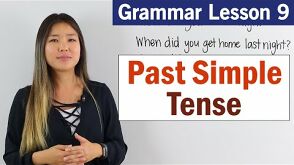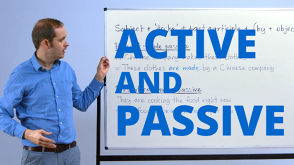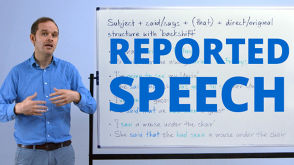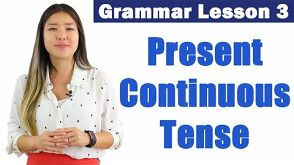Learn real English from movies and books.
Add words or phrases for learning and practice with other learners.
-
STEP 1Watch the video

-
STEP 2Do the exercises

-
STEP 3Add phrases you like to Favorites

Narrative Tenses
- 00:00 / 00:00
Click on a word or highlight a phrase to see translation
Click on a word or highlight a phrase to see translation
Click "plus" to add word/phrase for learning
Click "plus" to add word/phrase for learning
Start learning
Start learning
Using forms of the past tense to tell stories
When telling a story in English it is important to use forms of the past tense in English accurately because the form of the verbs gives important information to anyone listening or reading about the order or sequence of the events and the most important details of the story. For a story to be effective in English it should use the past simple, past continuous and past perfect.
Using Past simple when telling stories
The past simple, with regular and irregular verbs, is often used as the main event or most important action in a story that we want the reader or listener of our story to pay attention to. You can have more than one past simple event in a story as well.
Past simple:
Regular verbs (verb + -ed): walked, played, carried
Irregular verbs: ate, read, bought
-
The man crashed the car
-
The child ate too much then fell over
Using Past perfect when telling stories
The past perfect is used in storytelling to add more detail to the sequence of the stories allowing the storyteller to ‘jump' backwards in time and give information to the listener or reader about the events before the main events described with the past simple.
Past perfect: had + past participle
-
The police decided that the criminal had lied to them earlier
-
She had slept too much now she was tired
Using Past continuous when telling stories
To add background information or duration to a story we can use the past continuous in a story. The past continuous does not often focus the reader's or listener's attention to main or important events in a narrative The past continuous can also be used to describe events that are interrupted, using ‘when', or two events happening at the same time, using ‘while':
Past continuous: was/were + verb -ing
-
The man read the letter, the sun was shining
-
The wind was blowing outside, he opened the box
-
He was walking his dog when a bird attacked him
-
I was talking to my friend on the phone while I was walking on the street
Combining Narrative tenses to tell a better story
As mentioned earlier, to add depth, detail and quality to a story told in English, a storyteller needs to use all the past tense forms together. When we use the narrative tenses together in English it is important to remember that there is no right or wrong order to their usage. The meaning of the last two stories below is exactly the same but the emphasis is different because the information is given in a different order.
-
Chris' car crashed because he was driving too fast. He had drunk a lot of wine before the accident.
-
She had been asleep but now she was awake since the music was playing (The reader/listener's attention is focussed on the facts in the following sequence. Firstly, ‘she' was asleep then she wakes up and the background information is given at the end to give some details/context at the end )
-
The music was playing, now she was awake she had been asleep (This time, the story gives the reader/listener more context at the beginning, ‘the music was playing' before moving on to the main event, ‘she was awake', then we ‘jump' backwards to see what she had done before with the past perfect )
Similar video exercises
Click on a word or highlight a phrase to see translation
Click on a word or highlight a phrase to see translation
Click "plus" to add word/phrase for learning
Click "plus" to add word/phrase for learning











